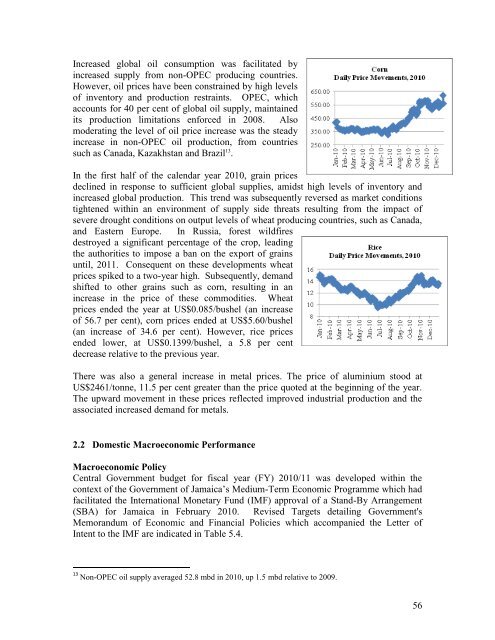PIOJ Growth-Inducement Strategy - Planning Institute of Jamaica
PIOJ Growth-Inducement Strategy - Planning Institute of Jamaica
PIOJ Growth-Inducement Strategy - Planning Institute of Jamaica
You also want an ePaper? Increase the reach of your titles
YUMPU automatically turns print PDFs into web optimized ePapers that Google loves.
Increased global oil consumption was facilitated by<br />
increased supply from non-OPEC producing countries.<br />
However, oil prices have been constrained by high levels<br />
<strong>of</strong> inventory and production restraints. OPEC, which<br />
accounts for 40 per cent <strong>of</strong> global oil supply, maintained<br />
its production limitations enforced in 2008. Also<br />
moderating the level <strong>of</strong> oil price increase was the steady<br />
increase in non-OPEC oil production, from countries<br />
such as Canada, Kazakhstan and Brazil 13 .<br />
In the first half <strong>of</strong> the calendar year 2010, grain prices<br />
declined in response to sufficient global supplies, amidst high levels <strong>of</strong> inventory and<br />
increased global production. This trend was subsequently reversed as market conditions<br />
tightened within an environment <strong>of</strong> supply side threats resulting from the impact <strong>of</strong><br />
severe drought conditions on output levels <strong>of</strong> wheat producing countries, such as Canada,<br />
and Eastern Europe. In Russia, forest wildfires<br />
destroyed a significant percentage <strong>of</strong> the crop, leading<br />
the authorities to impose a ban on the export <strong>of</strong> grains<br />
until, 2011. Consequent on these developments wheat<br />
prices spiked to a two-year high. Subsequently, demand<br />
shifted to other grains such as corn, resulting in an<br />
increase in the price <strong>of</strong> these commodities. Wheat<br />
prices ended the year at US$0.085/bushel (an increase<br />
<strong>of</strong> 56.7 per cent), corn prices ended at US$5.60/bushel<br />
(an increase <strong>of</strong> 34.6 per cent). However, rice prices<br />
ended lower, at US$0.1399/bushel, a 5.8 per cent<br />
decrease relative to the previous year.<br />
There was also a general increase in metal prices. The price <strong>of</strong> aluminium stood at<br />
US$2461/tonne, 11.5 per cent greater than the price quoted at the beginning <strong>of</strong> the year.<br />
The upward movement in these prices reflected improved industrial production and the<br />
associated increased demand for metals.<br />
2.2 Domestic Macroeconomic Performance<br />
Macroeconomic Policy<br />
Central Government budget for fiscal year (FY) 2010/11 was developed within the<br />
context <strong>of</strong> the Government <strong>of</strong> <strong>Jamaica</strong>’s Medium-Term Economic Programme which had<br />
facilitated the International Monetary Fund (IMF) approval <strong>of</strong> a Stand-By Arrangement<br />
(SBA) for <strong>Jamaica</strong> in February 2010. Revised Targets detailing Government's<br />
Memorandum <strong>of</strong> Economic and Financial Policies which accompanied the Letter <strong>of</strong><br />
Intent to the IMF are indicated in Table 5.4.<br />
13 Non-OPEC oil supply averaged 52.8 mbd in 2010, up 1.5 mbd relative to 2009.<br />
56
















